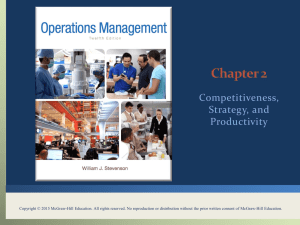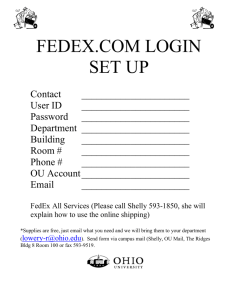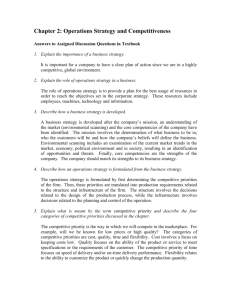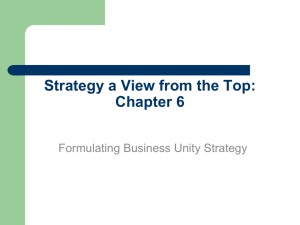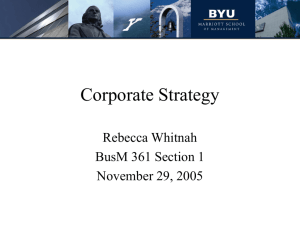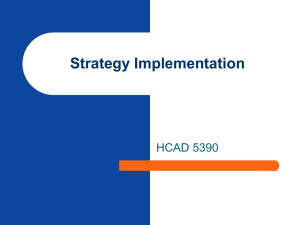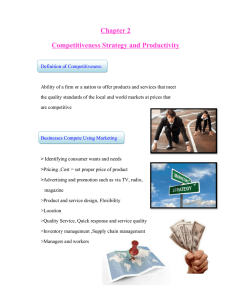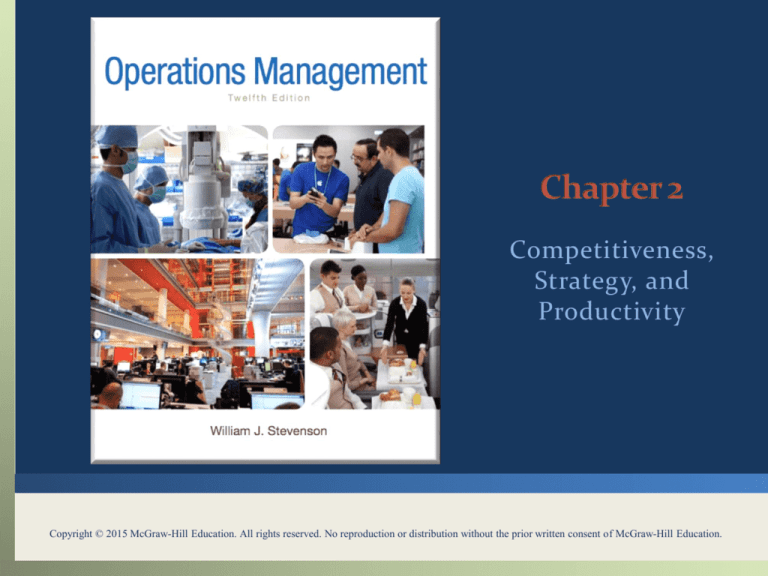
Competitiveness,
Strategy, and
Productivity
Copyright © 2015 McGraw-Hill Education. All rights reserved. No reproduction or distribution without the prior written consent of McGraw-Hill Education.
You should be able to:
LO 2.1 List several ways that business organizations compete
LO 2.2 Name several reasons that business organizations fail
LO 2.3 Define the terms mission and strategy and explain why they are
important
LO 2.4 Discuss and compare organization strategy and operations
strategy, and explain why it is important to link the two
LO 2.5 Describe and give examples of time-based strategies
LO 2.6 Define the term productivity and explain why it is important to
organizations and to countries
LO 2.7 Describe several factors that affect productivity
2-2
Better quality, higher productivity, lower costs, and the
ability to respond quickly to customer needs are more
important than ever, and…
the bar is getting higher
LO 2.1
2-3
This chapter focuses on three separate, but related
ideas that are vitally important to business
organizations
Competitiveness
Strategy
Productivity
LO 2.1
2-4
Competitiveness:
How effectively an organization meets the wants and
needs of customers relative to others that offer similar
goods or services
Organizations compete through some combination of
their marketing and operations functions
• What do customers want?
• How can these customer needs best be satisfied?
LO 2.1
2-5
Identifying consumer wants and/or needs
Pricing and quality
Advertising and promotion
LO 2.1
2-6
Product and service design
2. Cost
3. Location
4. Quality
5. Quick response
6. Flexibility
7. Inventory management
8. Supply chain management
9. Service
10. Managers and workers
1.
LO 2.1
2-7
1.
2.
3.
4.
5.
6.
7.
Neglecting operations strategy
Failing to take advantage of strengths and opportunities
and/or failing to recognize competitive threats
Too much emphasis on short-term financial performance
at the expense of R&D
Too much emphasis in product and service design and
not enough on process design and improvement
Neglecting investments in capital and human resources
Failing to establish good internal communications and
cooperation
Failing to consider customer wants and needs
LO 2.2
2-8
Mission
Goals
Organizational Strategies
Functional Strategies
Tactics
LO 2.3
2-9
Mission
The reason for an organization’s existence
It answers the question “What business are we in?”
Goals
Provide detail and the scope of the mission
Goals can be viewed as organizational destinations
Strategy
A plan for achieving organizational goals
Serves as a roadmap for reaching the organizational destinations
The organizational strategy guides the organization by providing
direction for, and alignment of, the goals and strategies of the
functional units
The organizational strategy is a major success/failure factor
LO 2.3
2-10
Mission
The reason for an organization’s existence
Mission statement
States the purpose of the organization
The mission statement should answer the question of
“What business are we in?”
LO 2.3
2-11
FedEx Corporation will produce superior financial returns for its
shareowners by providing high value-added logistics, transportation
and related information services through focused operating
companies. Customer requirements will be met in the highest quality
manner appropriate to each market segment served. FedEx
Corporation will strive to develop mutually rewarding relationships
with its employees, partners and suppliers. Safety will be the first
consideration in all operations. Corporate activities will be conducted
to the highest ethical and professional standards.
http://about.van.fedex.com/mission-strategy-values
LO 2.3
2-12
The mission statement serves as the basis for
organizational goals
Goals
Provide detail and the scope of the mission
Goals can be viewed as organizational destinations
Goals serve as the basis for organizational strategies
LO 2.3
2-13
Strategy
A plan for achieving organizational goals
Serves as a roadmap for reaching the organizational destinations
Organizations have
Organizational strategies
Overall strategies that relate to the entire organization
Support the achievement of organizational goals and mission
Functional level strategies
Strategies that relate to each of the functional areas and that support
achievement of the organizational strategy
LO 2.3
2-14
Tactics
The methods and actions taken to accomplish strategies
The “how to” part of the process
Operations
The actual “doing” part of the process
LO 2.3
2-15
Core Competencies
The special attributes or abilities that give an
organization a competitive edge
LO 2.3
To be effective core competencies and strategies need to be
aligned
2-16
Organizational
Strategy
Operations Strategy
Examples of Companies or Services
Low Price
Low Cost
U.S. first-class postage
Wal-Mart
Short processing times
McDonald’s restaurants
On-time delivery
FedEx
High performance design
and/or high quality processing
Sony TV
Consistent Quality
Coca-Cola
Differentiation:
Newness
Innovation
3M, Apple
Differentiation:
Variety
Flexibility
Burger King (Have it your way”)
Volume
McDonald’s (“Buses Welcome”)
Differentiation:
Service
Superior customer service
Disneyland
Differentiation:
Location
Convenience
Responsiveness
Differentiation:
High Quality
LO 2.4
IBM
Supermarkets; Mall Stores
2-17
Effective strategy formulation requires taking into
account:
Core competencies
Environmental scanning
SWOT
Successful strategy formulation also requires taking
into account:
Order qualifiers
Order winners
LO 2.4
2-18
Order qualifiers
Characteristics that customers perceive as minimum
standards of acceptability for a product or service to be
considered as a potential for purchase
Order winners
Characteristics of an organization’s goods or services that
cause it to be perceived as better than the competition
LO 2.4
2-19
Environmental Scanning is necessary to identify
Internal Factors
Strengths and Weaknesses
External Factors
Opportunities and Threats
LO 2.4
2-20
1.
2.
3.
4.
5.
6.
Economic conditions
Political conditions
Legal environment
Technology
Competition
Markets
LO 2.4
2-21
1.
2.
3.
4.
5.
6.
7.
8.
Human Resources
Facilities and equipment
Financial resources
Customers
Products and services
Technology
Suppliers
Other
LO 2.4
2-22
Operations strategy
The approach, consistent with organization strategy,
that is used to guide the operations function.
LO 2.4
2-23
Decision Area
What the Decisions Affect
Product and service design
Costs, quality, liability, and environmental issues
Capacity
Cost, structure, flexibility
Process selection and
layout
Costs, flexibility, skill level needed, capacity
Work design
Quality of work life, employee safety, productivity
Location
Costs, visibility
Quality
Ability to meet or exceed customer expectations
Inventory
Costs, shortages
Maintenance
Costs, equipment reliability, productivity
Scheduling
Flexibility, efficiency
Supply chains
Costs, quality, agility, shortages, vendor relations
Projects
Costs, new products, services, or operating systems
LO 2.4
2-24
Quality-based strategy
Strategy that focuses on quality in all phases of an
organization
Pursuit of such a strategy is rooted in a number of factors:
Trying to overcome a poor quality reputation
Desire to maintain a quality image
A desire to catch up with the competition
A part of a cost reduction strategy
2-25
Time-based strategies
Strategies that focus on the reduction of time needed to
accomplish tasks
It is believed that by reducing time, costs are lower, quality is
higher, productivity is higher, time-to-market is faster, and
customer service is improved
LO 2.5
2-26
Areas where organizations have achieved time
reductions:
Planning time
Product/service design time
Processing time
Changeover time
Delivery time
Response time for complaints
LO 2.5
2-27
Agile operations
A strategic approach for competitive advantage that
emphasizes the use of flexibility to adapt and prosper in
an environment of change
Involves the blending of several core competencies:
Cost
Quality
Reliability
Flexibility
2-28
A top-down management system that organizations can use to
clarify their vision and strategy and transform them into action
Develop objectives
Develop metrics and targets for each objective
Develop initiatives to achieve objectives
Identify links among the various perspectives
Finance
Customer
Internal business processes
Learning and growth
Monitor results
2-29
2-30
Productivity
A measure of the effective use of resources, usually
expressed as the ratio of output to input
Productivity measures are useful for
Tracking an operating unit’s performance over time
Judging the performance of an entire industry or
country
LO 2.6
2-31
High productivity is linked to higher standards of living
As an economy replaces manufacturing jobs with lower productivity
service jobs, it is more difficult to maintain high standards of living
Higher productivity relative to the competition leads to
competitive advantage in the marketplace
Pricing and profit effects
For an industry, high relative productivity makes it less
likely it will be supplanted by foreign industry
LO 2.6
2-32
Productivi ty =
Output
Input
Partial Measures
Output
;
Single Input
Multifactor Measures
Total Measure
LO 2.6
Ouput
;
Labor
Output
;
Multiple Inputs
Output
Capital
Ouput
;
Labor +Machine
Output
Labor +Capital +Energy
Goods or services produced
All inputs used to produce them
2-33
Units produced:
Standard price:
Labor input:
Cost of labor:
Cost of materials:
Cost of overhead:
5,000
$30/unit
500 hours
$25/hour
$5,000
2x labor cost
What is the
multifactor
productivity?
LO 2.6
2-34
Multifactor Productivity
=
Output
Labor +Material +Overhead
=
5,000 units $30/unit
(500 hours $25/hour) + $5,000 + (2(500 hours $25/hour))
=
$150,000
$42,500
= 3.5294
What is the implication of an unitless measure of productivity?
LO 2.6
2-35
Productivity Growth
=
Current productivity - Previous productivity
100%
Previous productivity
Example: Labor productivity on the ABC assembly line was 25 units per hour in
2014. In 2015, labor productivity was 23 units per hour. What was the
productivity growth from 2014 to 2015?
Productivity Growth
=
23 - 25
100% 8%
25
LO 2.6
2-36
Service sector productivity is difficult to measure and
manage because
It involves intellectual activities
It has a high degree of variability
A useful measure related to productivity is process yield
Where products are involved
ratio of output of good product to the quantity of raw material
input.
Where services are involved, process yield measurement is
often dependent on the particular process:
ratio of cars rented to cars available for a given day
ratio of student acceptances to the total number of students
approved for admission.
LO 2.6
2-37
Methods
Capital
Technology
LO 2.7
Quality
Management
2-38
1.
Develop productivity measures for all operations
2.
Determine critical (bottleneck) operations
3.
Develop methods for productivity improvements
4.
Establish reasonable goals
5.
Make it clear that management supports and encourages productivity
improvement
6.
Measure and publicize improvements
Don’t confuse productivity with efficiency
LO 2.7
2-39

